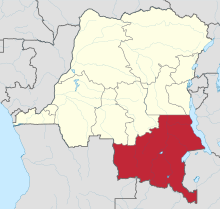Acalypha dikuluwensis
Appearance
| Acalypha dikuluwensis | |
|---|---|
| Scientific classification | |
| Kingdom: | Plantae |
| Clade: | Tracheophytes |
| Clade: | Angiosperms |
| Clade: | Eudicots |
| Clade: | Rosids |
| Order: | Malpighiales |
| Family: | Euphorbiaceae |
| Genus: | Acalypha |
| Species: | †A. dikuluwensis
|
| Binomial name | |
| †Acalypha dikuluwensis | |

| |
| Katanga Province, D.R. Congo | |
Acalypha dikuluwensis was a 25 centimetres (9.8 in) high[2] tropical flowering plant in the genus Acalypha of the family Euphorbiaceae. The IUCN Red List of Threatened Species declared the plant extinct in 2012. A. dikuluwensis was endemic to copper-rich soils of eastern Katanga Province of the Democratic Republic of the Congo, and was only found around Dikuluwe. The soils are derived from Katanga Supergroup Upper Cambrian Roan Group rocks.[3] It was restricted to steppic savanna in copper outcrops, which were destroyed by surface mining. No specimens were found after 1959.
References
- ^ Meersseman, A.; Faucon, M.-P.; Meerts, P.; Mahy, G.; Malaisse, F.; Ngongo Luhembwe, M. (2012). "Acalypha dikuluwensis". IUCN Red List of Threatened Species. 2012: e.T195373A2381395. doi:10.2305/IUCN.UK.2012-1.RLTS.T195373A2381395.en.
{{cite journal}}: Unknown parameter|last-author-amp=ignored (|name-list-style=suggested) (help) - ^ A. Radcliffe-Smith (1996). "Acalypha dikuluwensis". Flora Zambesiaca. 9 (4). Royal Botanic Gardens, Kew/JSTOR.
- ^ Faucon, Michel-Pierre; Meersseman, Arthur; Shutcha, Mylor Ngoy; Mahy, Grégory; Luhembwe, Michel Ngongo; Malaisse, François; Meerts, Pierre (2010). "Copper endemism in the Congolese flora: a database of copper affinity and conservational value of cuprophytes". Plant Ecology and Evolution. 143 (1): 5–18. doi:10.5091/plecevo.2010.411.
External links

